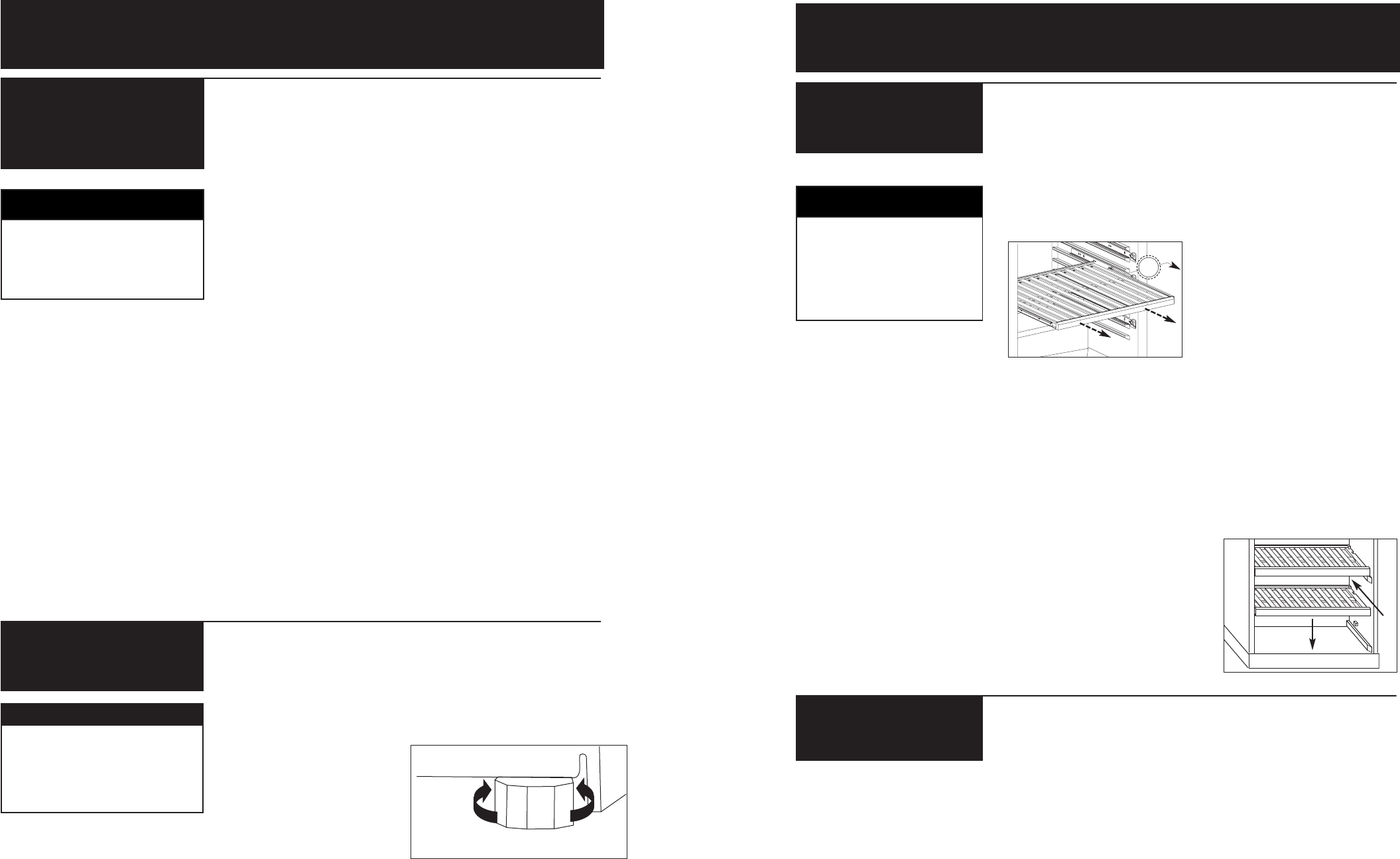
Operating Instructions
To remove a roller-shelf
(Fig.G):
1. Gently slide the shelf outward
until it meets resistance.
2. Tilt the shelf slightly upwards
(approximately 15°) and
carefully remove the shelf by
sliding it outward from the
cabinet.
To reinstall a roller-shelf:
1. Set the shelf’s wheels upon
the front of the wheel track.
2. Tilt the front of the shelf
slightly upwards (approxi-
mately 15°), and begin to
gently slide the shelf into the
cabinet until the shelf’s roller-
wheels slide naturally within
the wheel track.
To remove the bottom two
shelves:
1. Grasp the top, wooden area
of the shelf with your hand.
2. While grasping the shelf,
gently apply upward
pressure to the back of the
shelf and downward
pressure to the front of the
shelf.
3. Begin to slowly pull the shelf
outward until it unhooks
from the stoppers, and then
remove the shelf from the
cabinet.
To reinstall the bottom two
shelves (Fig. H):
1. Slide the shelf beneath the
track that is
directly above
the track you want the shelf
to rest on.
2. Once the back-end of the
shelf is in contact with the
back wall of the cabinet,
lower the shelf onto the
track.
Shelf Instructions
Fig. G
IMPORTANT!
Do not cover shelves with
aluminum foil or any other
material that will prevent
adequate air circulation
within the cabinet.
1
2
15°
1
2
Fig. H
Este artefacto debe ser conec-
tado a tierra. En caso de un
corto circuito eléctrico, la
conexión a tierra reduce el
riesgo de una descarga eléc-
trica proporcionando un cable
de retorno para la corriente
eléctrica.
Este artefacto viene con un
cable de alimentación que
tiene un conductor y pata del
enchufe de tierra. Este cable
debe enchufarse en un toma-
corriente debidamente instala-
do y con conexión a tierra.
Si no entiende claramente las
instrucciones de conexión a
tierra, o si no está seguro de
que su tomacorriente esté cor-
rectamente conectado a tierra,
llame a un electricista califica-
do.
Si el tomacorriente es uno
común de 2 patas, es su
responsabilidad personal y
obligación el reemplazarlo por
uno de 3 patas correctamente
conectado a tierra.
Para obtener el mejor resulta-
do, enchufe este artefacto en
su propio tomacorriente para
evitar que las luces titilen,
quemar un fusible o disparar
una llave térmica.
Nunca, bajo ninguna circun-
stancia, corte o remueva la
tercera pata (tierra) del
enchufe.
No use un enchufe adaptador
con este artefacto
No use un cable de prolon-
gación con este artefacto. Si
el cable de alimentación es
demasiado corto, haga que un
electricista calificado o un téc-
nico de reparaciones instale
otro tomacorriente más cerca
del artefacto.
INSTRUCCIONES
DE LA CONEXIÓN
A TIERRA
INFORMACIÓN IMPORTANTES DE SEGURIDAD
ATENCIÓN
La conexión inadecuada del
cable de tierra puede
causar riesgo de descarga
eléctrica.
28
¡ATENCIÓN!
Equipo muy pesado
Use 2 o más personas para
mover el heladera para vinos.
Debajo de la rejilla de venti-
lación de la unidad hay dos
patas niveladoras, una a cada
lado de la rejilla. Es impor-
tante que el enfriador de vino
quede nivelado:
Para nivelar el enfriador de
vino:
1. Mueva la unidad a su
emplazamiento definitivo.
2. Haga que una persona se
apoye suavemente sobre el
borde delantero de la
unidad para quitarle peso
temporalmente a las patas
niveladoras.
3. Para levantar la unidad,
gire las patas niveladoras a
la izquierda y a la derecha
para bajarla. Continúe
hasta nivelar la unidad. Vea
la Fig. A.
Instrucciones
para nivelar
Fig. A
subir
bajar
Moving &
Vacations
If you move
1. Remove or securely
fasten down all loose
items inside the wine
cooler.
2. To avoid damaging the
leveling screws, turn
them all the way into the
base.
Vacation Time
For short vacation periods,
leave the controls at their
usual settings. During longer
absences;
1. Remove all bottles.
2. Disconnect from
electrical outlet.
3. Clean the wine cooler
thoroughly.
4. Leave the door open to
avoid formations of
condensate, mold or
odors.
9


















